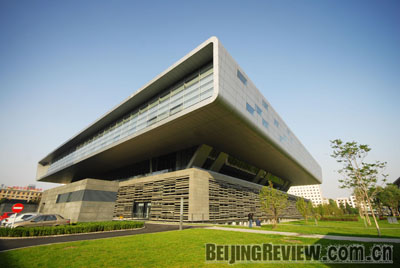|

|
|
A NEW CHAPTER: With the opening of the new building, the National Library of China has become the largest repository of Chinese books and digital information (WEI YAO) |
September 9, 2008 marked a milestone for the 99-year-old National Library of China (NLC). On that day, the Phase II Project of the NLC, an expansion that took four years to complete and cost 1.2 billion yuan ($175.7 million), was opened to the public.
After the expansion, NLC has space to meet the storage needs of the coming three decades. With a construction area of 250,000 square meters, it has become the third largest national library in the world. It has a total collection of 26 million volumes/items, ranking fifth among national libraries all over the world. It is also the largest repository of Chinese books and digital information.
The National Digital Library is the highlight of the expanded NLC. According to the library, it has 200-terabytes of digital resources (1TB=1,024GB). Zhan Furui, Director of the NLC, said that it is among the largest in the world.
The Phase II Project is to the north of the original NLC building and resembles a giant book. The building has a total construction area of 80,538 square meters, with five floors above the ground and three underground. It has about 3,000 seats and can cater to 8,000 readers daily.
The new building consists of reading and research rooms, art and recreation zones and features large open spaces, modern design, rich collections and hi-tech facilities.
Intelligent facility
The digitalized intelligent building is designed to be reader-friendly. Upon entering the library, one sees an escalator that can carry visitors all the way up to the fourth floor. According to Deputy Director Zhang Yuhui, the escalator is 28 meters long and 13.45 meters high, the highest escalator in Beijing.
Lighting in the new building has been improved by 50 percent. The exterior walls and the ceiling are glass and with a courtyard and atrium structure, the building is well lit by natural sunlight. During the daytime, one can read in the reading rooms without switching on electric lights. Electric lights are only needed on overcast or rainy days and at night.
From the first floor underground to the fourth floor above ground, all the space is open. Visitors do not need to push open any doors. On the back cover of every book is an intelligent chip that can tell the location of the book. Librarians can identify misplaced books with a hand-held scanner. Once scanned, the misplaced book will sound an alarm, and the position it should be placed in will be displayed on the screen of the scanner.
Radio Frequency Identification (RFID) labeling technology allows readers to borrow or return books at the self-service machines. The automatic check out or return service takes no more than 20 seconds and is a solution to congestion at the front desk.
The new building is also covered by wireless Internet service. About 400 computers allow users easy access to digital resources. The library also provides readers with a hand-held E-reading device, each with a liquid crystal display and a chip that stores more than 500 e-books. Users can access all the electronic resources in the library by plugging the E-reading device into a USB outlet, and download the resources they need.
With new facilities, the library has also adopted a more service-oriented strategy. Previously, the librarians in the NLC spent considerable energy keeping an eye on library users, in case that they damaged or stole books. Now, social values have changed considerably, and the general public sees the library as a place to enrich themselves, while the librarians view users as customers who need their service.
The library emphasizes a meticulous and individualized friendly service. In the word of Zhan, a librarian should be the reader's shadow, appearing whenever needed, and disappearing otherwise, so as to give readers a relaxed and comfortable reading environment.
The new building is spacious and bright, warm and cozy. Comfortable sofas are placed all over the library and readers can get free water from drinking machines.
An innovation in the new building is a special section for vision-impaired people, who can access library resources through voice-controlled computers or a digital library specially designed for them.
In addition, the NLC is working with a large cable TV service provider, Beijing Gehua CATV Network Co. Ltd., exploring ways to access library resources through televisions. If the experiment is successful, the 2 million users of Gehua cable service will be able to access the homepage of the NLC, listening to lectures online or querying information. In the meanwhile, the NLC is also cooperating with mobile communication service providers, which will allow readers to query library information, read the most current newspapers, or access a small amount of documents through their cell phones.
| 